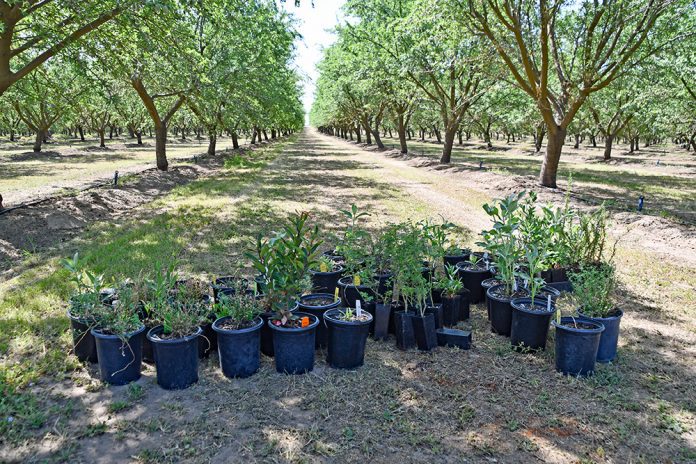
British poet William Cowper was quoted in the 1700s as saying, “Variety is the spice of life.” The same could be said for pollinator hedgerows, plantings of flowering perennial native shrubs and forbs along the edges of farm fields and orchards that increase habitat diversity.
The goal isn’t so much to provide food and shelter for European honeybees but for native pollinators, such as bumblebees, moths, beetles, wasps, flies, butterflies, birds, small mammals and more. The hedgerows also can serve beneficial insects that prey on crop pests and even reduce soil erosion in some cases.
The efforts are part of a national effort included in the 2018 Farm Bill, which retained important pollinator provisions from the previous two farm bills. It also added new ones to enhance pollinator habitat enhancement and protection.
Along with several other pollinator advocacy groups, the East Stanislaus Resource Conservation District has been working with several Central Valley farmers the past few years to install native plantings, said Andrea Brophy, East Stanislaus RCD communications manager.
Wes Sperry, a grower of conventional almonds who also has 125 acres in organic production near Roberts Ferry, is a beneficiary. This spring, with the district’s help, he installed a hedgerow to complement the cover crop he already established on the floor of his organic orchard.
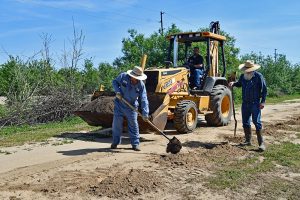
“We’re focused on soil health and trying to be as light on the land with our farming practices as we can,” Sperry said. “It comes down to farming like an ecosystem and having good pollinators and good native insects that can benefit the farm, I think, is part of our goal here. Creating habitat for those insects is important, so we felt hedgerows are a nice complement to some of the other practices we’re doing already.”
He credited Ward and Rosie Burroughs, Denair regenerative organic almond producers, for mentoring him with his organic orchard.
“We feel blessed, so we like to pay it forward for young farmers,” Ward Burroughs said. “It’s something we share with them and love to help. We’re really proud about what Wes is doing.”
The RCD hosted a field day this spring at Sperry’s organic almond orchard so attendees could learn firsthand about hedgerows. They also got a chance to get their hands dirty by helping plant the native selections.
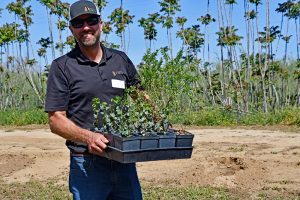
Factors to Consider
Although the goal of a hedgerow is to increase biological diversity within an orchard, Brophy said there really is no right or wrong answer for the number of plant species or overall number of plants to include.
“Obviously, diversity is important,” she said. “But if you only have a small budget, then get as many as you can, maybe 5 to 10 species. Every plant has a different cost, so it depends on the person and the budget.”
Having a hedgerow comprising a wide variety of plants also makes it more resilient. If a pest targets one plant species, you still have several others left.
Bloom timing is critical, so pollinators have season-long pollen and nectar sources. In a perfect world, Brophy said a hedgerow should have at least three different species for each bloom timing to ensure overlap.
Having variations in plant canopy height, from low to high, also is important to create structural variations in habitat, which provide more diversity and fits the needs of more wildlife, said Deedee Soto, Natural Resource Conservation Service area-wide planner for Area 3. It includes the Central Valley and neighboring foothills. In addition, the variations offer pollinators shelter and protection from weather and predators.
For growers who have concerns about erosion, such as along a canal bank, Soto can recommend several plant species that do double duty.
“They’re much smaller plants, but they have a lot of pollinator benefits and payoffs as well,” Brophy said.
Regardless of the objective, Soto said, growers should avoid applying pesticides near hedgerows to protect pollinators.
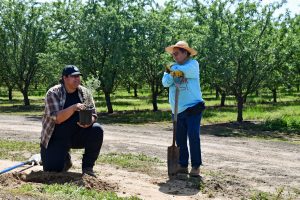
Native Vegetation’s Influence
Along one side of Sperry’s orchard is an abandoned canal that has reverted to native vegetation, including elderberry, oaks and willows. Planted adjacent to the canal, the hedgerow will extend the native corridor, bringing it closer to the orchard.
“Wes had quite a bit of room, but other orchards we have installed them in didn’t have that luxury,” Brophy said. “You don’t want to fragment habitat, but if you can’t do anything else, it’s better than nothing.”
Sperry’s hedgerow consists of 17 different species and a total of 140 plants on drip with 1 gallon-per-hour emitters. Once volunteers put the plants in the ground, they raked almond shells from the Burroughs around them as mulch to help reduce weed pressure and moisture loss. Keeping weeds at bay to avoid competition when the plants are young is vital to establishment, Soto said.
Sperry planned to irrigate the plants for a year or two to establish them, then turn off the water and let them rely on natural rainfall. Because the species are native to California, they typically don’t require much water.
“They’re drought tolerant,” Soto said. “Overwatering can kill them easier than underwatering.”
The first phase, which included 70 plants, was put in the ground in early March, about a month before the field day. Based on the earlier efforts, Sperry said he was pleased.
“This is our first run at it, we’ll see how things go,” he said. “But the piece we’ve planted already looks great.”
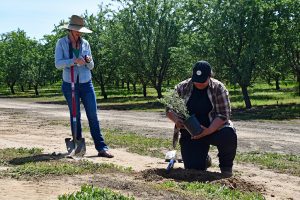
Getting Guidance
Brophy admitted trying to select the proper plant species for a geographic area while factoring in plant height and bloom timing can be daunting on your own. That’s why she recommended working with one or more groups that have expertise in the area.
In addition to the local RCD, they include NRCS, Xerces Society, Pollinator Partnership, Monarch Joint Venture and Seeds for Bees.
Two of Brophy’s go-to references are pollinator plant lists developed for the Sacramento Valley and Central Valley. The species may differ slightly between regions because of variations in weather and temperature.
“It’s going to be super intimidating for anyone just starting out,” she said. “That’s why I developed Sacramento and Central Valley plant lists. They give you all of the information like bloom time and whether they’re shrubs or annuals.”
Brophy and Soto also can recommend sources of drought-tolerant native plants since they’re not readily available at home centers or retail nurseries.
For more information on California pollinator plants, download the Xerces Society’s fact sheet at xerces.org/publications/plant-lists/pollinator-plants-california. Soto can be reached at 661-432-5294 or deedee.soto@xerces.org.
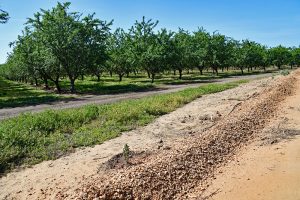

Vicky Boyd | Contributing Writer
A veteran agricultural journalist, Vicky Boyd has covered the industry in California, Florida, Texas, Colorado, the South and the Mid-South. Along the way, she has won several writing awards. Boyd attended Colorado State University, where she earned a technical journalism degree with minors in agriculture and natural resources. Boyd is known for taking complex technical or scientific material and translating it so readers can use it on their farms. Her favorite topics are entomology, weeds and new technology. When she’s not out “playing in the dirt,” as she calls agricultural reporting, Boyd enjoys running, hiking, knitting and sewing.















